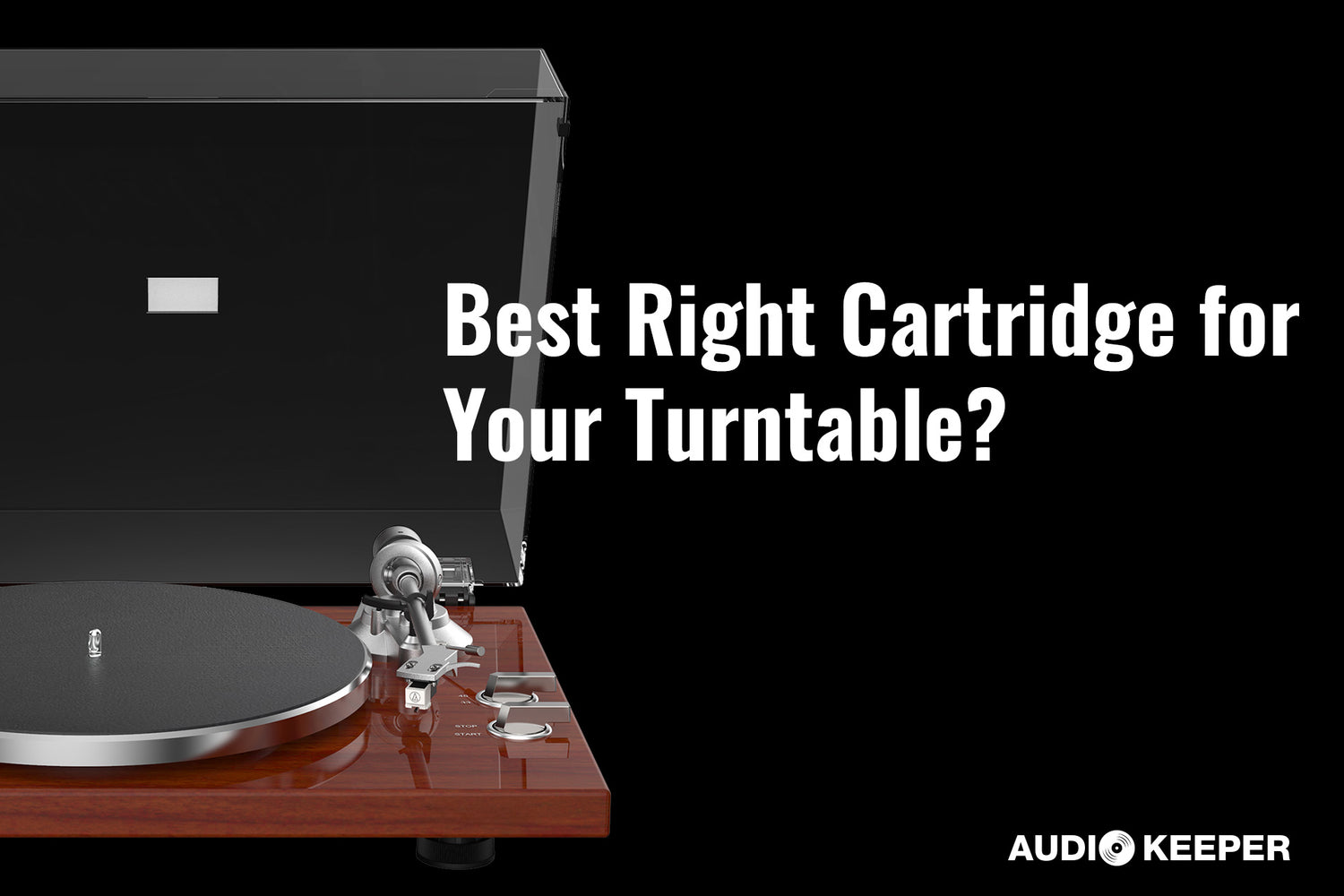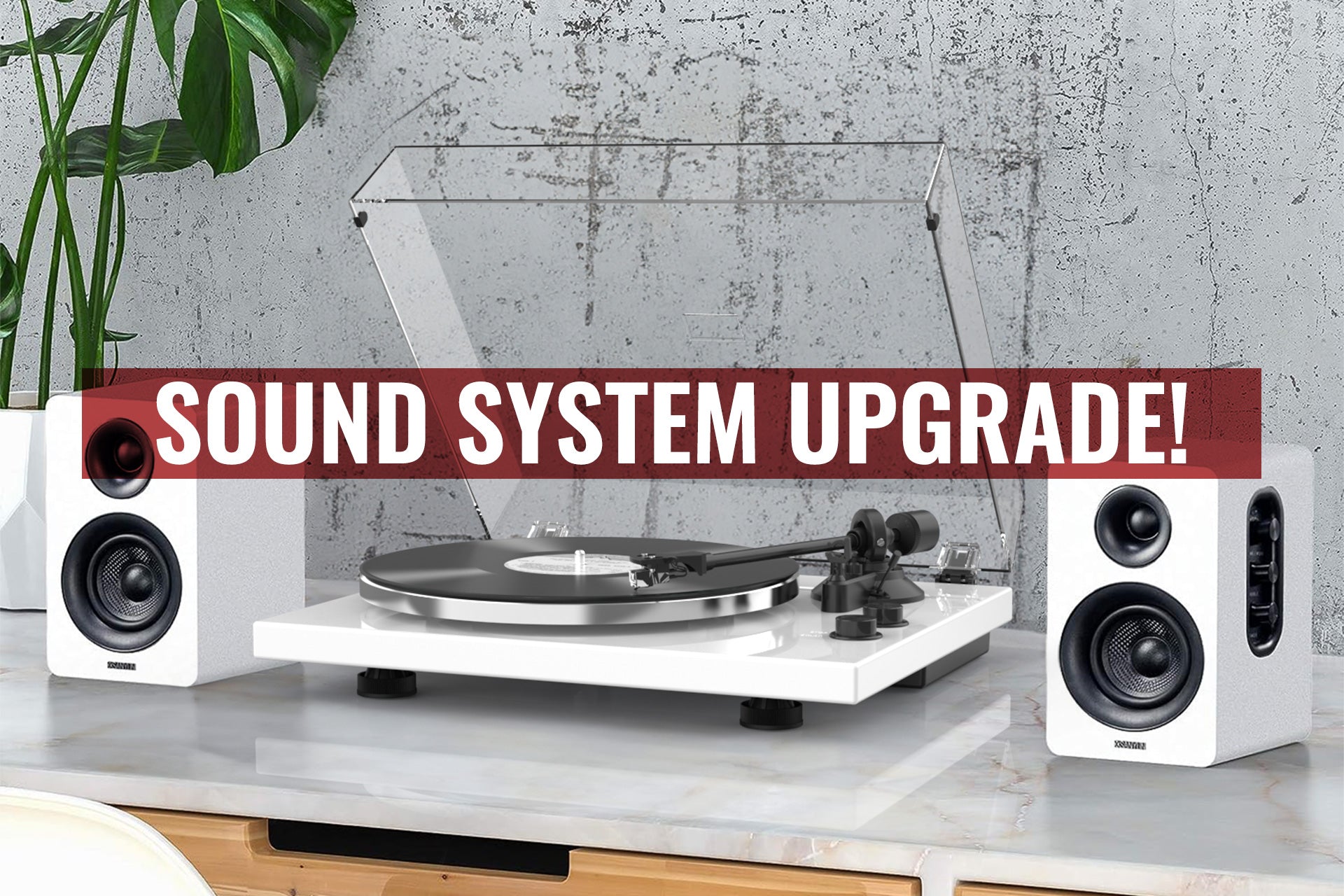Among vinyl enthusiasts who pursue the best sound quality, choosing the appropriate cartridge is crucial to polishing a personalized sound system. This article will take an in-depth look at how to pick the right cartridge for your vinyl turntable, from basic concepts to technical specs to help you find your perfect fit in the world of audio.
Part 1: Understanding the Basics of Phonograph Cartridges
1.1 Basic structure of cartridge
Before we delve into how cartridges work, we first need to understand the basic construction of different types of cartridges, which mainly include magnetic and quartz cartridges.
1. Magnetic cartridge: Magnetic cartridges are a common design and are divided into two main types:
- Moving Magnet (MM) and Moving Coil (MC). Moving Magnet (MM) cartridge: This type of cartridge generates an electrical signal by moving a magnet between a fixed magnet and a coil attached to the tone arm. MM cartridges are generally more affordable, easy to install, and perform well in high frequency bands.
- Moving Coil (MC) cartridge: Compared with MM cartridges, MC cartridges generate electrical signals by moving a small coil on the stylus in a magnetic field. MC cartridges are usually lighter, more sensitive, and have better performance in the dynamic range and low-frequency response of audio, making them suitable for users who pursue high-fidelity sound quality.
2. Quartz cartridge: Quartz cartridges use quartz elements to achieve vibration. This design pursues higher stability and accuracy. Quartz cartridges generally perform well in terms of sound quality, and have unique advantages in reducing mechanical noise and improving audio resolution. However, due to its sophisticated design, the price is higher and is suitable for audiophiles with higher sound quality requirements.
Understanding how cartridges work is the basis for why different types of cartridges are suitable for different needs. Magnetic cartridges generate electrical signals through a combination of magnetic fields and motion, and are cost-effective and widely applicable. Quartz cartridges use quartz components to pursue higher audio accuracy and stability, and are suitable for users who pursue excellent sound quality. When choosing a cartridge, an understanding of these basic constructions will help better suit your audio needs.
1.2 Differences between magnetic and coil cartridges
Magnetic Cartridge vs. Coil Cartridge: Features Comparison
When choosing a cartridge, it is crucial to compare the characteristics of magnetic and coil cartridges in depth. The following is a detailed comparison of their output voltage, sound quality performance and applicable scenarios:
1. Output voltage:
- Magnetic cartridges: Typically have higher output voltages, which makes them easier to match with a variety of preamps and sound systems. This means you can choose from a wider range of devices to match without having to worry about compatibility issues.
- Coil cartridges: Generally speaking, coil cartridges have a lower output voltage. This may require a higher sensitivity preamplifier to ensure correct amplification of the signal. Suitable for some professional audio systems that pursue higher signal processing accuracy.
2. Sound quality performance:
- Magnetic cartridge: Generally considered to excel in the high frequency range, producing a clear, bright sound quality. They also perform well in the lower and mid-range frequencies, but may be more limited in these frequencies than coil cartridges.
- Coil cartridges: generally perform better in terms of low frequencies and dynamic range, providing deeper bass and greater dynamic response. For users who are pursuing higher fidelity sound quality, especially in scenes with strict bass requirements, coil cartridges may be a better choice.
3. Applicable scenarios:
- Magnetic cartridge: Suitable for a wide range of audio scenarios, especially those with high requirements for high-frequency response and clarity. Suitable for a variety of music styles, from pop to classical.
- Coil cartridge: Suitable for scenes that require higher bass and dynamic range, such as jazz, classical music, or professional recording studio environments that require higher audio accuracy.
Your personal audio preferences and usage scenarios will be the deciding factors when choosing between magnetic and coil cartridges. Magnetic cartridges have advantages in output voltage and wide applicability, making them suitable for a wide range of users. The coil cartridge has better low-frequency and dynamic range performance, making it suitable for professional users who pursue higher sound quality. When weighing the pros and cons, consider your equipment mix and personal listening needs to find the cartridge type that works best for you.
Part 2: Understanding your vinyl turntable and audio needs
2.1 Consider the tonearm type and connection method
1. Turntable type:
- Direct Drive Turntable: The motor of a direct drive turntable is directly connected to the turntable shaft, providing a more direct drive. This design typically provides more accurate speed control and is suitable for applications requiring high speed accuracy. When choosing a cartridge, you need to make sure it is compatible with a direct drive system to get the most out of its performance.
- Belt drive turntable: The belt drive turntable connects the motor and the turntable through a belt, which reduces vibration and noise in mechanical transmission. This design is usually more suitable for users who are pursuing sound quality, because it can provide smoother rotation and reduce the impact of mechanical noise on sound quality. When choosing a cartridge, you need to consider how the turntable is driven to make sure the cartridge matches it.
2. Connection method:
- Quality of the connecting plug: The audio signal from the vinyl turntable is transmitted to the audio system via the connecting plug. High-quality connection plugs can reduce signal distortion and improve audio transmission efficiency. Choose a high-quality plug with a metal shell and good contacts to ensure stable transmission of audio signals.
3. The weight and inertia of the cartridge:
- Turntable inertia and cartridge weight: The mass and inertia of the turntable arm will affect cartridge selection. Some cartridges may be more sensitive to greater mass and inertia, and therefore require a corresponding arm to maintain balance. When choosing a cartridge, understand the characteristics of your turntable's arm to make sure the cartridge will work with it.
When choosing a cartridge, you need to consider the type of vinyl turntable, the connection method, as well as the inertia of the arm and the weight of the cartridge. Proper matching of these factors can ensure that the audio system works harmoniously to provide the best sound quality and audio performance. Before picking a cartridge, learn more about your vinyl turntable's technical specifications and design features to ensure your choice maximizes its potential.
2.2 Determine audio needs and personalized preferences
Before choosing a phono cartridge, it's important to understand your personal audio needs and preferences. Here are some key factors that may influence your choice:
1. Clarity and bass requirements:
- Pursue clarity: If you value audio clarity, you may be tempted to choose a cartridge that can accurately deliver high-frequency details. This may be more important for users who listen to complex music, classical music, or who focus on vocal performance.
- Bass Emphasis: If you emphasize bass more, you might want to choose a cartridge that provides powerful bass. This is suitable for scenes such as jazz, rock or pop music that require rich bass performance.
2. Timbre preference:
- Bright tone: Users who like bright tone may choose cartridges that perform well in the high frequency band, making the music clearer and sharper.
- Warm sound quality: Users who prefer warm sound quality may look for cartridges that excel in the mid-low frequency range for a softer, richer tone.
3. Audio style and type:
- Influence of music type: Different music types may have different requirements for cartridges. For example, classical music may require greater clarity, while rock music may require more powerful bass.
4. Budget considerations:
- Budget Constraints: Your budget is also a deciding factor. With so many phono cartridges to choose from, there are different price ranges to choose from, and there's a balance to be found between performance and budget.
5. Brand and model:
- Brand trust: Some users may prefer to trust a specific brand or model. The reputation of the brand and user reviews of the cartridge can influence the choice.
Before choosing a cartridge, clarifying one's audio needs and personal preferences is key to ensuring the final choice meets expectations. Understanding your pursuit of sound quality, preference for high and low sounds, and demand for music type will help you find the most suitable cartridge among a wide range of choices and enhance your music experience.
Part 3: Dive deeper into technical specifications and performance evaluation
3.1 Impedance, voltage output and frequency response
When considering cartridges, a solid understanding of technical specifications is a critical step in ensuring compatibility and superior performance. Here are some important technical parameters that need to be studied in depth to ensure that cartridge selection is coordinated with the vinyl turntable and sound system:
- 1. Impedance:
Understand Impedance Matching: Make sure the impedance of the cartridge matches the sound system. Different cartridges and sound systems may have different impedance requirements. Matching impedance maximizes audio signal transmission and ensures good audio performance.
- 2. Output Voltage:
Adapt to the preamplifier: Know the voltage output of the cartridge to make sure it's appropriate for the preamplifier you're using. Lower output cartridges usually require a higher sensitivity preamplifier. High-output cartridges are better suited to standard or low-sensitivity preamplifiers.
- 3. Frequency Response:
Match your sound system: Learn more about the frequency response range of your cartridge to make sure it matches your sound system. The broad frequency response helps deliver a more comprehensive, balanced audio performance.
- 4. Cartridge type (Moving Magnet (MM) or Moving Coil (MC)):
Match the turntable and sound system: Know the type of cartridge, whether it is MM or MC. Different types of cartridges may require different preamps and interfaces, so make sure it's compatible with your turntable and sound system.
- 5. Vertical Tracking Force: Maintaining Proper Tracking Force:
Know the range of horizontal tracking force required by the cartridge. Correct tracking is critical to the protection and sound performance of vinyl records. Make sure your cartridge has the right tracking power for your turntable.
- 6. Needle type and shape:
Suitable for record types: Know the type and shape of the stylus used in the cartridge to make sure it is suitable for the types of records you often play. The choice of stylus plays an important role in protecting the record and obtaining the best sound quality.
Diving into the cartridge's technical specifications is key to ensuring it will work in harmony with your vinyl turntable and sound system to deliver excellent sound quality. Carefully understanding these parameters and choosing a cartridge that works with your configuration will help maximize the potential of your sound system.
3.2 Consider the magnetic field form of the magnetic cartridge
For users who choose magnetic cartridges, a thorough understanding of their magnetic field forms, including the differences between Moving Magnet (MM) and Moving Coil (MC), is the key to ensuring performance matching. Here is a detailed comparison of these two types of magnetic cartridges:
1. Moving Magnet (MM) cartridge:
- Construction and working principle: In the MM cartridge, the magnet is fixed on the cartridge and the coil is connected to the tone arm. As the stylus moves in the groove of the record, the magnet moves relative to the coil, producing an electrical signal.
- Output Voltage: Generally speaking, MM cartridges have relatively high output voltages, making them easier to use with a variety of preamplifiers and sound systems.
- Easy to adjust and replace: MM cartridges are usually relatively affordable and easy to adjust and replace, making them the first choice for many users.
2. Moving Coil (MC) cartridge:
- Construction and Working Principle: In MC cartridge, the coil is fixed on the cartridge while the magnet is connected to the tone arm. The movement of the stylus causes the coil to move relative to the magnet, generating an electrical signal.
- Output voltage: Generally speaking, MC cartridges have lower output voltage. This requires a higher sensitivity preamplifier, but also results in greater audio accuracy.
- High-fidelity performance: MC cartridges usually perform better in low frequency and dynamic range, and are suitable for users who pursue high-fidelity sound quality.
Selection suggestions:
- Sound System Compatibility: Make sure the magnetic cartridge you choose is compatible with your sound system. Some sound systems may be better suited for MM cartridges, while others are better suited for MC cartridges.
- Preamplifier Requirements: Consider the output voltage and impedance requirements of your preamplifier. Some systems may require a high-sensitivity preamp specifically designed for use with MC cartridges.
- Personal sound quality preference: Understand your own sound quality preference, whether you prefer a higher output voltage and affordable MM cartridge, or a MC cartridge with higher fidelity performance.
Understanding the differences between MM and MC cartridges is critical to ensuring performance matches. Based on personal preferences, sound system configuration and budget considerations, choose the most suitable magnetic cartridge to achieve excellent sound quality and meet individual needs.
Part 4: Practical considerations in the selection process
4.1 Budget and performance balance
Finding the best choice among the many phono cartridge brands and models that fit your budget and performance needs is an important task. Here are some suggestions to help you find a balanced cartridge without breaking the bank:
- 1. Determine budget range:
Be clear on your budget: Before you start your search, be clear on the budget range you are willing to invest. This helps narrow down your choices and makes it easier to find options that meet your financial requirements.
- 2. Focus on performance-price ratio:
Research different brands and models: Learn about different brands and models of cartridges and what they say about performance, durability, and sound quality. Look for performance-price options, i.e. cartridges that offer great performance at a relatively low price. User Reviews and Professional Reviews: Read other user reviews and professional reviews to get more information about cartridge performance and real-world experience. This helps determine whether a certain cartridge meets your expectations.
- 3. Consider the second-hand market:
Look for second-hand options: Looking for a cartridge on the second-hand market can be an affordable option. Make sure the cartridge is still in good condition and meets your requirements.
- 4. Understand the different series of the brand:
Brand's low-priced range: Some brands may have low-priced ranges specifically designed for the entry market. Products in these series are generally more reasonably priced but still perform reliably.
- 5. Consider upgrade paths:
Understand the brand's upgrade paths: Some brands offer upgrade paths that allow you to upgrade to a higher-performance cartridge later if needed. Allowing for the possibility of future upgrades, this should keep you covered for your audio needs longer.
- 6. Match with other audio components:
Ensure compatibility with other components: Make sure the cartridge you choose is compatible with your vinyl turntable, sound system and preamplifier. Avoid selecting a cartridge that may cause a system mismatch.
Budget is a key factor when choosing a cartridge, but also make sure the performance matches your expectations. Through careful research and comparison, you can find cartridges that offer good performance within your affordability and meet your audio needs.
4.2 Consider maintenance and upgradeability
As the core component of the audio system, the cartridge's maintenance and upgradeability are key factors to ensure the system's continued high-level performance. Here are some suggestions for cartridge durability and upgrade options:
1. Durability of cartridge:
- Regular Cleaning and Maintenance: Cleaning and maintenance of the cartridge is essential to ensure its proper operation and longevity. Follow the manufacturer's cleaning recommendations and use appropriate tools and cleaning fluids to prevent dust and dirt from affecting the cartridge.
- Set the tracking force appropriately: Regularly check and adjust the horizontal tracking force of the cartridge to ensure it is working within the normal range. Tracking force that is too high or too low can damage the record or the cartridge itself.
2. Upgrade options:
- Brand's upgrade path: Find out whether the phono cartridge brand provides an upgrade path. Some brands have designed upgrade series that allow you to upgrade to a higher performance cartridge in the future without having to replace the entire system.
- Swapping the stylus: Some cartridges allow the user to replace the stylus. By changing the stylus, you can improve the performance of the cartridge and adapt it to different types of records without having to replace the entire cartridge.
3. Regular inspection and maintenance:
- Check cables and connections: Check your cartridge's cables and connections regularly to make sure they are not damaged or loose. A solid connection helps maintain good audio transmission.
- Periodic calibration: Some cartridges may require periodic calibration to ensure optimal performance in your audio system. Consult the manufacturer's guidelines on how to perform calibration correctly.
4. Study user experience:
- Check out the user community: Participate in cartridge-related user communities to learn about other users’ experiences and suggestions. This can provide you with reliable information about your specific cartridge, as well as best practices for maintenance and upgrades.
Understanding cartridge durability and upgradeability is key to ensuring continued excellence in your sound system. By regular cleaning and maintenance, as well as considering upgrade options, you can maximize the life of your cartridge and maintain a high level of system performance.
Conclusion
Thank you very much for reading! With an in-depth understanding of cartridge basics, vinyl turntable and audio needs, as well as technical specifications and performance reviews, you'll be able to more confidently choose the right cartridge for your sound system. In the process of building a sound system, the choice of cartridge is indeed one of the key steps that affects personalization and excellent sound quality. I hope this article can be a helpful guide for you on this journey and make your musical journey even more remarkable. If you have any further questions or need more help, please feel free to ask me. May your audio experience always be filled with great music!












Leave a comment
All comments are moderated before being published.
This site is protected by hCaptcha and the hCaptcha Privacy Policy and Terms of Service apply.